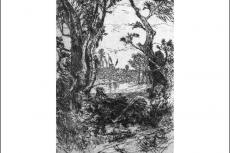The four candidates vying for two seats on the East Hampton Town Board agreed on some issues and differed on others in a largely staid Oct. 18 debate hosted by the League of Women Voters of the Hamptons, Shelter Island, and North Fork.
With four candidates, time allowed for opening and closing statements and just four questions, some having been asked of the candidates for supervisor in a debate that immediately preceded it.
With water quality, affordable housing, and preservation of land and rural character among the top issues confronting the town’s government, the candidates were asked about priorities for community preservation fund money. Scott Smith, one of two Republican and Conservative Party candidates, called the C.P.F. “a fantastic idea” intended to preserve large tracts of land and farmland as well as “the country feeling that we all love.” But it has been abused, he said, with the purchase of small lots that he said “decreases the availability of land for our residents. . . . So many families are leaving East Hampton because they can’t afford to live here.” He advocated use of C.P.F. money for wastewater treatment, identifying Ditch Plain in Montauk as the top priority.
Councilman David Lys, the only incumbent among the four candidates, took exception to Mr. Smith’s remarks. “The town has been very aggressive in progressing into accumulating farmlands,” the Democratic and Working Families Party candidate said, listing the acquisition of farmlands in Amagansett, East Hampton, and, most recently, Springs, “to bring back our agrarian lifestyle.” The town, he said, “does not buy quarter-acre lots. I don’t know where that reference is coming from with the C.P.F. unless it potentially has multiple wetlands or some type of high environmental criteria. . . . We are very, very sensitive to the supply and demand of land and how the C.P.F. is used for it.” Democratic leadership on the town board, Mr. Lys added, has “effectively used the C.P.F. fund for the last 20 years, specifically over the last six that I’ve been on the town board.”
Michael Wootton, the other Republican and Conservative Party candidate, agreed that water quality “has to be a top priority,” calling attention to rampant overuse of pesticides and fertilizer, as well as antiquated septic systems, and the hazard all pose to waterways and the sole-source aquifer. On the day of a candidates forum in Montauk early this month, he noted, the MightyMan Montauk triathlon had to be modified as Fort Pond was unsafe for swimming. He suggested public education and possibly limiting or banning the use of pesticides and fertilizers, and greater use of bioswales to filter water before it enters waterways.
Tom Flight, the other Democratic and Working Families Party candidate, noted that today’s concerns about overdevelopment and resulting environmental degradation echo those that led to creation of the C.P.F. a quarter-century ago, but the fund has been a buffer against such overdevelopment. “That is why this area is such an outstanding spot. It’s those kinds of policies that we need to continue as we move forward to ensure that we continue to preserve as much of this natural, beautiful environment as we can.”
Asked about communication and cooperation between the town board and the town trustees, Mr. Lys said that the relationship is strong and “getting stronger, most recently in the last 10 years.” Over that time, Democrats have seized a large majority on the nine-member board of trustees, and the sole incumbent Republican is cross-endorsed by the town’s Democratic committee. A seat on the town’s Water Quality Technical Advisory Committee is filled by a trustee, as is a position on the Nature Preserve Committee, Mr. Lys said, “so there’s great communication there with the trustees.”
Mr. Smith used the question to criticize the town board’s Democratic supermajority. The question, he said, is about the relationship between the trustees and town employees. “And right now in Town Hall . . . there is a lack of pride, there’s a lack of camaraderie, there’s a lack of feeling that they are part of something. The communication, from what I understand, from the current town board with the employees of the town is nonexistent.” He wants “people to feel appreciated, loved, and part of a movement, which I think has been lacking for so long in Town Hall.”
Mr. Wootton seconded Mr. Smith’s remarks. “The morale among town employees is very, very low,” he said, pointing to the acute shortage of affordable housing that he said leaves town employees stressed and financially insecure.
The town board and trustees share many goals, chiefly water quality, Mr. Flight said. “It’s not just about imposing ideas and saying ‘town operations aren’t where you want to be,’ it’s about doing. I think that active communication with people is key, but also investing in ways to have better communication between the two organizations is critical as well.”
The candidates were in agreement that the deer population is too high and must be reduced for the sake of public safety, citing vehicle collisions and the Lyme disease carried by ticks. Mr. Flight suggested a possible cull combined with a sterilization effort. “Whatever happens, it has to be done in a humane fashion as much as possible,” he said. “We have to recognize the deer as part of our environment, and we have to ensure going forward that we have a healthy, well-looked-after deer population in the ecosystem.”
Mr. Smith agreed, speaking of his time working on a cattle ranch in Montana and the “boom-and-bust populations of deer,” disease sometimes decimating a herd. “Culling a herd, in my opinion, is the solution to getting the deer population down,” which he said could be accomplished with local hunters rather than hiring specialists. He also suggested use of four-poster stations, feed stations that use corn to bait deer and then treat them with a pesticide to kill ticks.
Mr. Lys suggested use of nuisance permits to allow hunters to cull deer on permitted properties. Any action, however, should be subject to study and community discussion “to find out where there is a consensus,” he said.
“Hunters that I speak to are very humane,” Mr. Wootton said. “I think that culling the herd is one useful way to keep the population down.”
One question concerned marijuana, and its potential as a source of tax revenue. The town board voted unanimously to opt out of allowing retail dispensaries or on-site consumption licenses late in 2021, following New York State’s legalization of recreational cannibis use by adults. Municipalities that opted out can opt back in, but the board has not publicly discussed the issue since opting out.
Mr. Wootton said that he agrees with the town board’s decision to opt out. “I think marijuana use does not help our teenagers one bit,” he said. “Especially for young minds that are developing, I think it creates a degree of passivity, and I’d rather see those teenagers outside playing or getting away from their cellphones or P.C.s.”
Mr. Lys agreed, and said that the town board proactively banned smoking of any kind on beaches in response to the legalization of marijuana and the popularity of vaping among youth.
Mr. Smith said that he, too, opposed allowing recreational cannabis sales in the town. “It’s not a motivator for children to smoke marijuana and then go out and participate in sports, go to the beach, go to the Y.M.C.A., learn how to surf,” he said. “Across the board, I am not for having legalized marijuana shops in the Town of East Hampton.”
Only Mr. Flight, who is an emergency medical technician, had a different take. With respect to controlled substances, “probably the most dangerous one I see out there is alcohol, not marijuana,” he said. “The patients who have excessive alcohol consumption turn violent, they’re difficult to deal with, and it’s a public nuisance” for both police and emergency medical personnel. “Very few of those calls are related to marijuana.”
Marijuana has been used for a long time, he said, and will continue to be, “irrespective of it being legal in East Hampton. I am of the school of thought that it’s far better to have a regulated industry than an unregulated one. If we are able to control how marijuana is sold in the Town of East Hampton and tax it, I think could potentially be a good thing.” He said that he understood why the board opted out, as there were many unanswered questions at the time. “I think the bigger question here is why are people using it,” he said. “It’s a mental health issue. People use alcohol and drugs . . . and I think we need to ensure we as a town continue . . . to implement mental health resources to help people through difficult times instead of using drugs.”
Profiles of the four candidates for the town board, and the two candidates for supervisor, will appear in next week’s issue of The Star.




